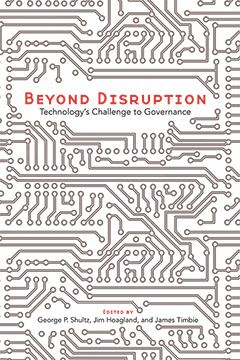In Beyond Disruption: Technology’s Challenge to Governance, George P. Shultz, Jim Hoagland, and James Timbie present views from some of the country’s top experts in the sciences, humanities, and military that scrutinize the rise of post-millennium technologies in today’s global society. They contemplate both the benefits and peril carried by the unprecedented speed of these innovations—from genetic editing, which enables us new ways to control infectious diseases, to social media, whose ubiquitous global connections threaten the function of democracies across the world.
Decision makers are watching as a surge of new technologies begin to take hold of nearly every industry. Beyond Disruption’s contributors explore this rapid wave of technological advancement and assess its impact on society and national security. Some techniques, like the advent of machine learning, have enabled engineers to create systems that will make us more productive. For example, self-driving vehicles promise to make trucking safer, faster, and cheaper. However, using big data and artificial intelligence to automate complex tasks also ends up threatening to disrupt both routine professions like taxi driving and cognitive work by accountants, radiologists, lawyers, and even computer programmers themselves.
Brookings Institution Nonresident Senior Fellow William Drozdiak authored chapter 7: “Governance from an International Perspective.” This chapter examines how technological advancements are a double-edged sword: they offer a great leap forward for humanity – instant communications around the globe or the creation of driverless cars that curtail deadly accidents – providing democracies with tools to empower the voices of common people; but they can also be viewed as potential threats to political order, shared prosperity, and stable communities.
The full versions of this chapter, and the book, are available here.
Authors
Contributions by
